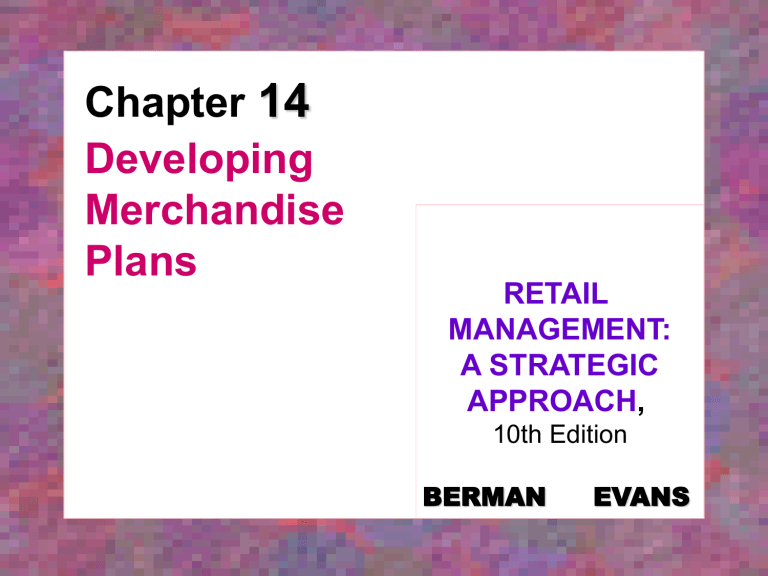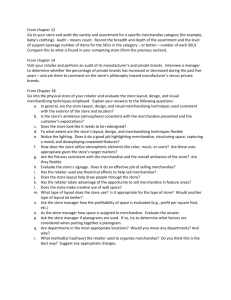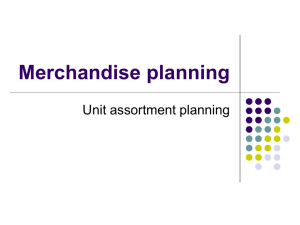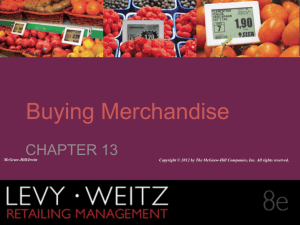File

Chapter
14
Developing
Merchandise
Plans
RETAIL
MANAGEMENT:
A STRATEGIC
APPROACH ,
10th Edition
BERMAN EVANS
Chapter Objectives
14-2
To demonstrate the importance of a sound merchandising philosophy
To study various buying organization formats and the processes they use
To outline the considerations in devising merchandise plans: forecasts, innovativeness, assortment, brands, timing, and allocation
To discuss category management and merchandising software
14-3
Merchandising
Activities involved in acquiring particular goods and/or services and making them available at the places, times, and prices and in the quantity that enable a retailer to reach its goals
Merchandising Philosophy
Sets the guiding principles for all the merchandise decisions that a retailer makes
Should reflect
* Target market desires
*
Retailer’s institutional type
* Market-place positioning
* Defined value chain
* Supplier capabilities
* Costs
* Competitors
* Product trends
14-4
Scope of Merchandising
Responsibility
Full array of merchandising functions
* Buying and selling
* Selection, pricing, display, customer transactions
OR
Focus on buying function only
14-5
14-6
Figure 141: Nike’s Own Store
Merchandising Philosophy
14-7
Micromerchandising
Retailer adjusts shelf-space allocations to respond to customer and other differences among local markets
14-8
Cross-Merchandising
Retailers carry complementary goods and services to encourage shoppers to buy more offer warranties
Functions Performed
Merchandising view
* All buying and selling functions
• Assortments
• Advertising pricing
• Point-of-sale displays
• Employee utilization
• Personal selling approaches
14-9
Functions Performed (cont.)
Buying view
* Buyers manage buying functions
• Buying
• Advertising
• Pricing
* In-store personnel manage other tasks
• Assortments
• Point-of-sale displays
• Employee utilization
• Personal selling approaches
14-10
14-11
Figure 14-5: Devising
Merchandise Plans
Forecasts
These are projections of expected retail sales for given periods
* Components:
• Overall company projections
(Estimation)
• Product category projections
• Item-by-item projections
• Store-by-store projections (if a chain)
14-12
Types of Merchandise
Staple merchandise
Assortment merchandise
Fashion merchandise
Seasonal merchandise
Fad merchandise
14-13
14-14
Staple Merchandise
Regular products carried by a retailer
* Grocery store examples: milk, bread, canned soup
Basic stock lists specify inventory level, color, brand, style, category, size, package, etc.
Assortment Merchandise
Apparel, furniture, auto, and other categories for which the retailer must carry a variety of products in order to give customers a proper selection
Decisions on Assortment
* Product lines, styles, designs, and colors are projected
14-15
Fashion and Seasonal
Merchandise
Fashion Merchandise: Products that may have cyclical sales due to changing tastes and life-styles
Seasonal Merchandise: Products that sell well over nonconsecutive time periods
14-16
Assessing each Factors in Planning
Merchandise Innovativeness
FACTOR
Target market(s)
Goods/service growth potential
Fashion trends
Retailer image
RELEVANCE for PLANNING
Evaluate whether the target market is conservative or innovative
Consider each new offering on the basis of rapidity of initial sales , maximum sales potential per time period, and length of sales life
Understand vertical and horizontal fashion trends, if appropriate
Carry goods/services that reinforce the firm’s image
14-17
Table 14-1b: Factors in Planning
Merchandise Innovativeness
FACTOR
Competition
RELEVANCE for PLANNING
Lead or follow competition in the selection of new goods/services
Customer segments Segment customers by dividing merchandise into established-product displays and new-product displays
Responsiveness to consumers
Carry new offerings when requested by the target market
Amount of investment
Consider all possible investments for each new good/service: product costs, new fixtures, and additional personnel
14-18
FACTOR
Profitability
Risk
Table 14-1c: Factors in Planning
Merchandise Innovativeness
Constrained decision making
Declining goods/ services
RELEVANCE for PLANNING
Assess each new offering for potential profits
Be aware of the possible tarnishing of the retailer’s image, investment costs, and opportunity costs
Restrict franchisees and chain branches from buying certain items
Delete older goods/services if sales and/or profits are too low
14-19
14-20
Figure 14-7: Traditional Product
Life Cycle
14-21
Retail Assortment Strategies
Width of assortment refers to the number of distinct goods/service categories
(product lines) a retailer carries
Depth of assortment refers to the variety in any one goods/service category
(product line) a retailer carries
An assortment can range from wide and deep (department store) to narrow and shallow (box store)
14-22
Brands
Manufacturer
(national)
Private
(dealer or store)
Generic
Timing & Location
Timing : For new produces the retailer should decide when they are first purchased, displayed and sold the must plan the merchandising flow per during a year
Location : location of products in store and stockroom or warehouse to be used
14-23





